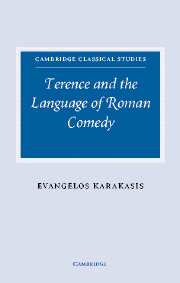Book contents
- Frontmatter
- Contents
- Acknowledgements
- Conspectus siglorum
- Introduction
- Part I Linguistic differentiation in Terence
- 1 Colloquialisms
- 2 Archaisms
- 3 Senilis μακρολογία and περισσολογία
- 4 Hellenisms
- 5 Features of elevated language
- 6 Idiolect
- 7 Plautus in Terence: the case of Eunuchus
- Part II Linguistic and stylistic unity in Roman comedy
- Bibliography
- Index locorum
- Index nominum et rerum
2 - Archaisms
Published online by Cambridge University Press: 22 September 2009
- Frontmatter
- Contents
- Acknowledgements
- Conspectus siglorum
- Introduction
- Part I Linguistic differentiation in Terence
- 1 Colloquialisms
- 2 Archaisms
- 3 Senilis μακρολογία and περισσολογία
- 4 Hellenisms
- 5 Features of elevated language
- 6 Idiolect
- 7 Plautus in Terence: the case of Eunuchus
- Part II Linguistic and stylistic unity in Roman comedy
- Bibliography
- Index locorum
- Index nominum et rerum
Summary
Introduction and overall review
Terence stands closer to CL than Plautus. There is, however, a group of lexical, morphological and syntactical phenomena that occur in Terence in both their Early Latin and their classical forms. In these cases the EL equivalent seems to be rather the exception than the rule; it is found rarely, whereas the CL equivalent is the regular form. In Terence one often finds that the EL feature is restricted to specific plays or characters, while all others use the CL form.
Maltby was the first to show that such EL linguistic features are often used by old people (satias for the CL satietas, ai(e)bam imperfects, scilcet + infinitive constructions); such features impart an old-fashioned character to senile speech, differentiating it from the language of all other characters, who opt for the CL equivalent. Even though some of Maltby's conclusions are to be proved correct, his work suffers from some methodological infelicities. In detail:
He uses insufficient data, especially on the morphological and lexical level.
Several of the examples he adduces do not correspond to the safe criterion set out by him in his introduction for characterising a specific feature as EL, namely that the feature in question should occur in EL sources and disappear from the later history of the language with the exception of archaising authors or genres (e.g. Fronto, Apuleius, epic of the classical era etc.). For example, the faxo, faxim forms, although being EL -sso, -ssim formations, never cease to exist and are well attested as formulaic or fossilised forms in both CL and PC Latin.
[…]
- Type
- Chapter
- Information
- Terence and the Language of Roman Comedy , pp. 44 - 61Publisher: Cambridge University PressPrint publication year: 2005

